MENU
MENU
Tea production area: Minamikyushu City, Shibushi City, Kirishima City, Makurazaki City, Soo City, Kagoshima City, Kanoya City, Hioki City, Kinko City, Satsuma Town, Satsumasendai City, Yakushima Town, Osaki Town, Nishinomote City, etc.
Brand: Kagoshima tea, Chiran tea, Shibushi tea, Ariake tea, Kirishima tea, Makurazaki tea, Sueyoshi tea, Soo tea, Takarabe tea, Kanoya tea, Hioki tea, Matsumoto tea, Tashiro tea, Oonejime tea, Satsuma tea, Miyanojo tea, Tanegashima tea
Types of tea: Sencha (lightly steamed green tea), fukamushicha (deep steamed green tea), kukicha (stem tea), matcha, tencha, hojicha (roasted green tea), genmaicha (green tea with roasted rice), gyokuro (high-quality shaded tea), kabusecha (shaded green tea), black tea, bancha, powdered tea, oolong tea, flavored tea, etc.
Kagoshima tea
Kagoshima Prefecture is one of the major tea production regions in Japan and tea is cultivated throughout Kagoshima Prefecture, including remote islands such as Tanegashima Island and Yakushima Island, etc.
The brand name of tea cultivated in Kagoshima Prefecture was united under the name of Kagoshima tea. However, there are tea brands for each region such as Chiran tea, Kirishima tea, etc.
History of Kagoshima tea
There are various theories about the origin of Kagoshima tea. One of them says that during the Muromachi Period (1336 – 1537) a monk who was from Uji served as a chief priest of Hannya-ji temple in Yusui Town and he brought tea seeds from Uji and planted them at the temple.
Lightly and medium steamed greens tea are made in the Northern part of the Prefecture, which has a high altitude, in places such as Kirishima City. Deep steamed tea is mainly produced on the flatland in the Southern part of the Prefecture.
Various types of teas are made throughout the Prefecture.
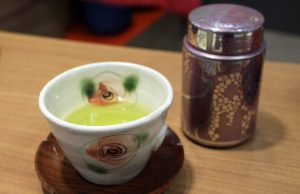
Kirishima tea and Satsuma tinned tea canister (March 2018)
Chiran tea
In 2007, Ei Town, Kawabe Town, and Chiran Town merged to form Minamikyushu City. As a result, Minamikyushu became the largest tea-production city as a municipality in Japan. Eicha, Kawabecha, and Chirancha in Minamikyushu City were unified under the name of Chiran tea in 2017.
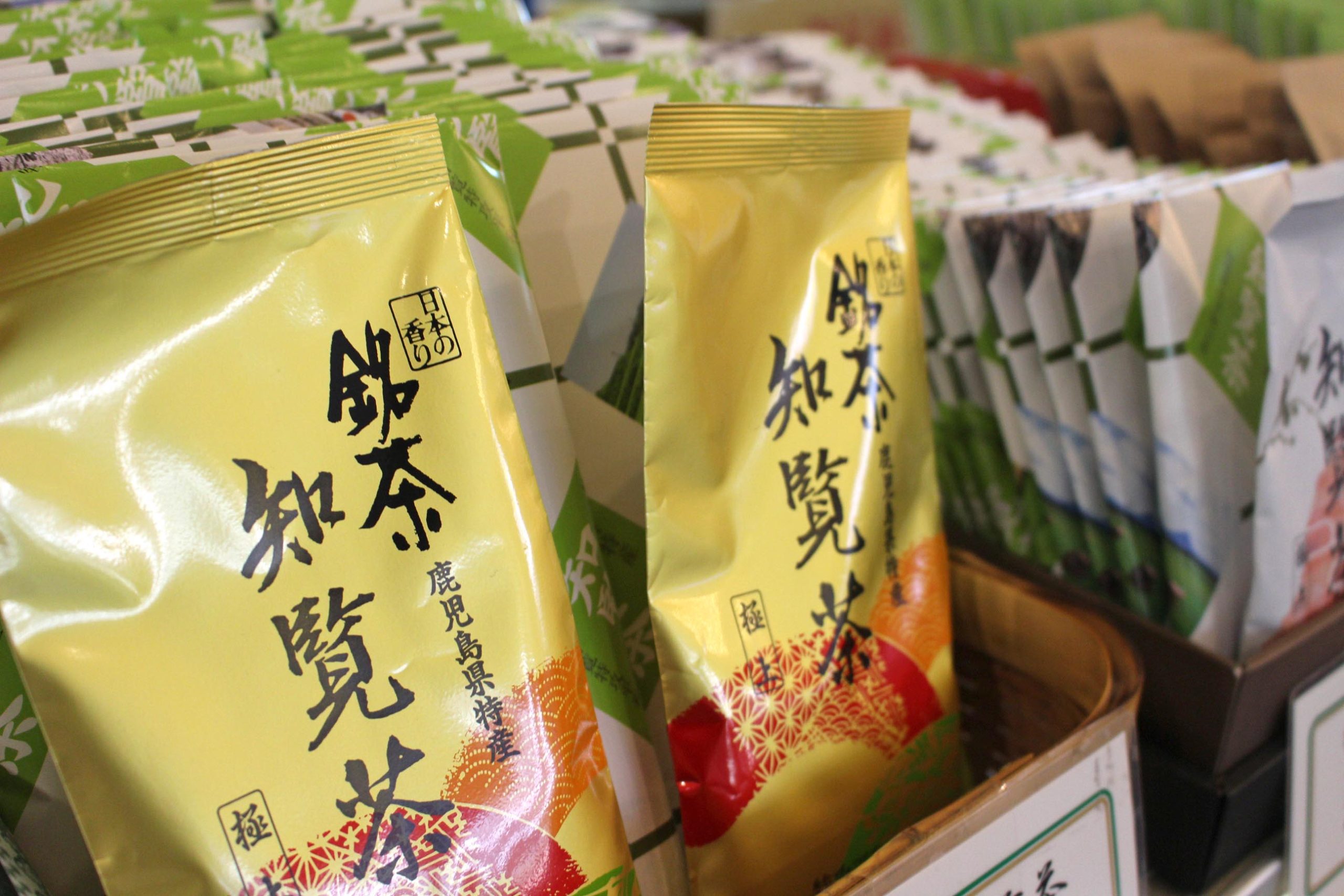
Chiran tea at Chiran Peace Museum (March 2018)
There are many facilities related to tea such as tea houses and restaurants, where sweets and dishes using tea are served.
Satsuma Eikokukan serves their original Chiran black tea and scones.
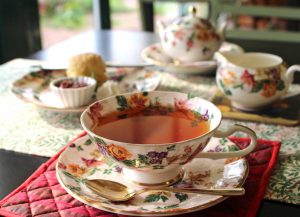
Satsuma Eikokukan Tea World (March 2018)
Ohashiri-shincha 大走り新茶
Ohashiri refers to the earliest harvested product of the season and shincha means newly picked tea. Kagoshima Prefecture is located in the southernmost part of Kyushu Island and is blessed with warm weather all year round. Tea plucking starts at the end of March on Yakushima Island and Tanegashima Island. On the other hand, tea plucking starts around the end of April to the beginning of May in other regions. The tea leaves plucked on the islands are shipped as Ohashiri-shincha to the tea markets in places such as in Shizuoka Prefecture.
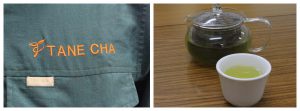
Tanegashima tea at Tanegashima Island producer association (April 2018)
Mechanization and labor-saving in the tea industry
Kagoshima Prefecture has large-scale tea plantations on flat lands such as Minamikyushu City, Minamisatsuma City, Makurazaki City and Shibushi City. It is not difficult to introduce machines for tea cultivation on flat land compared to mountainous regions. Mechanization and labor-saving have been promoted in the tea industry of Kagoshima Prefecture.
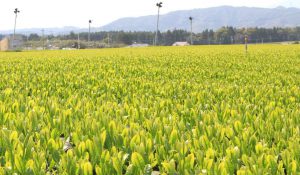
Tea fields in Shibushi City (April 2018)
Chabakkenoka (Takatsukaoka) 茶ばっけん丘 (高塚丘)
There is a low hill of Takatsukaoka in Chiran Town and it is called Chabakkenoka commonly. Chabakkenoka means a hill found in tea fields in the Kagoshima direct.
You can see vast tea fields and Mt. Kaimondake from the hill. The scenery of the morning sun and tea fields is fantastic.
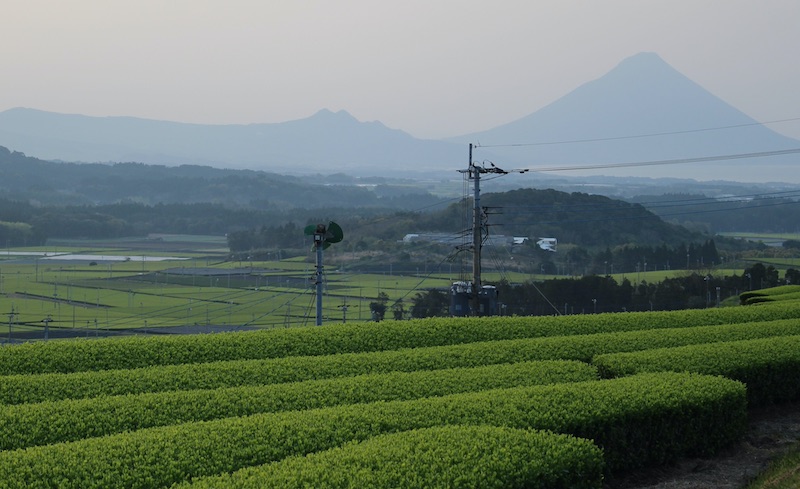
The view from the top of Chabakkenoka (March 2018)
Chaju-kaidan 茶寿階段
Mt. Kaimondake and vast tea fields can be seen on the top of Mt. Oonodake in Ei Town, Minamikyushu City. If climbing to the top of Mt. Oonodake, you walk up 108 steps of the stair. The stair is named Chaju-kaidan (茶寿階段) which means steps for celebrating one’s 108th birthday.
There is a custom of celebrating longevity on the 60th, 70th, 77th, 88th, 90th, 100th and 108th birthdays in Japan. Celebrating the 108th birthday is called Chaju (茶寿). “Cha” (茶) means tea and “Ju” (寿) means celebration. The Chinese character 茶 can be broken down into Chinese numerals 十 (10), 十 (10), 八十八 (88). The total of these numbers is 108.

Chaju-kaidan in Oonodake Park (March 2018)
Chabushi 茶節
Ibusuki City is located in Minami-satsuma region in Kagoshima Prefecture, and the city is one of the representative katsuobushi production places in Japan. Katsuobushi is simmered, smoked, fermented, and dried skipjack tuna. Katsuobushi shavings are eaten as a topping on various food such as tofu in Japan.
In this region, there is a local dish called chabushi, which uses tea, katsuobushi shavings and miso (fermented soybean paste). Miso is put into a teacup with katsuobushi shavings, before adding cut green onions, ginger, eggs, etc. Finally, green tea is poured over before stirring. It is said that drinking chabushi is an effective cure for hangovers. Chabushi is good as a breakfast or as a snack. An instant chabushi is sold, and it is easy to make and drink chabushi.
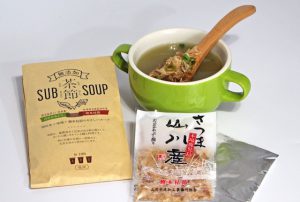
Instant chabushi SUB SOUP produced by Yamakawa Suisan kogyokyodokumiai
Cuisine using tea
Green tea pork shabushabu can be eaten in Chiran Town, Minamikyushu City. Slices of local premium-branded pork “Satsuma-chamiton” are parboiled in green tea soup. The pigs of the pork are fed fodder that contains a compound found in green tea (catechins) and sweet potato.
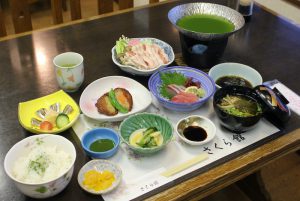
Green tea shabushabu at Sakurakan (March 2018)
Full course lunch using tea
A tea company, Horiguchiseicha Wakoen runs an original tea cuisine restaurant “Saonnokura” in Shibushi City. The restaurant serves a full-course lunch and all the dishes and desserts are made using tea. The menu changes seasonally. Reservation is required.
の蔵鹿児島県有明町原田和香園6-1-300x200.jpg)
Green tea tofu of full-course lunch at Saonnokura (March 2018)
Hanzucha (Hanzu tea) of Hioki City
There was a simple and unique tea-making method historically in Hioki City. Fresh tea leaves were fired in a hanzu (water jar) on a kiln. The tea was called Hanzucha (Hanzu tea).
Immigrants from Shizuoka started tea cultivation in Tanegashima Island
Atsuyoshi Makino (1846〜1923), the first head of Kumage District of Tanegashima was from former Ogasa-gun (current Kikugawa City), Shizuoka Prefecture. When he returned to his hometown in 1902 after retirement, he reported to people who worked in the tea industry that Tanegashima Island was suitable for tea cultivation. Then, the people of Ogasa-gun immigrated to Tanegashima Island in 1909. They cleared the land of bushes and began cultivating tea.
There is a memorial stone monument to commemorate the 100th anniversary of immigration to Banyamine Village, Furuta District on Tanegashima Island.
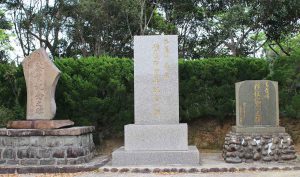
Stone monuments to commemorate the immigration (April 2018)
Kaya grows around the tea fields and cut kaya is put in the tea fields in Furuta District. It is the same as Shizuoka’s Chagusaba farming method which is conducted in Kikugawa City traditionally.
Kaya is another name for Japanese pampas grass, reeds, and cypress which are gramineous perennial grasses.
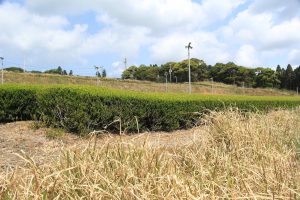
Tea fields with Kaya in Furuta District, Tanegashima Island (March 2018)
Monuments of tea seed in Tanegashima Island and Kikugawa City
There are statues of tea seeds that are of the same design, but different sizes on Tanegashima Island and Kikugawa City.
The monument was designed by sculptor Daido Nakajima. In 2009, a large monument was installed in front of JR Kikugawa Station and a small one was installed in front of Banyamine community center on Tanegashima Island.
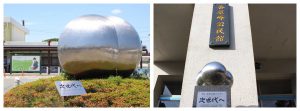
Photo left: Tea seed monument in Kikugawa City (June 2019)
Photo right: Tea seed monument in Tanegashima Island (April 2019)
Fuicha (Fui tea) of Tokunoshima Island
There was a custom of drinking Fuicha (Fui tea) on Tokunoshima Island. Fuicha is similar to the Bukubukucha (Bukubuku tea) of Okinawa Prefecture. Fuicha is bancha whisked in a wooden bowl, but unlike Bukubukucha food is not added to the drink.
Tea related facilities:
南九州市知覧観光協会 高塚丘「茶ばっけん丘」
大野岳公園と茶寿階段
英国薩摩館Tea World http://www.satsuma-eikokukan.jp
和香園 茶の創作料理茶音(さおん)の蔵
http://www.wakohen.co.jp/saonkura/saonkura.htm
さくら館、知覧茶御膳 http://www.chiran-sakurakan.com
Tea mascot Yuru-Chara:
お茶むらい(南九州市)
茶ノミコト(霧島茶キャラクター)
鹿児茶丸(鹿児島県茶生産協会)
お茶わんこはがねちゃん(志布志市)
4-300x200.jpg)
A vending machine with an illustration of ochamurai at Onodake Park (March 2019)
Ceramic and pottery art: Satsuma ware
Chiran peace museum
Minamikyushu City is a place of tea and peace.
At the end of World War II, the Kamikaze Corps (special attack corps) who were fighters equipped with bombs crashed into enemy battleships deliberately. There was a sortie base of the Kamikaze Corp in Minamikyushu City. Photographs of the deceased and the articles they left behind, including farewell notes of Kamikaze pilots, are exhibited at the Chiran Peace Museum.

Chiran peace museum (March 2018)
Reference:
松下智 (平成3年) 日本名茶紀行 (初版) 雄山閣出版
高野實・谷本陽蔵・富田勲・中川致之・岩浅潔・寺本益英・山田新市 (2005) 緑茶の事典 (改訂3版) 柴田書店
大森正司、阿南豊正、伊勢村護、加藤みゆき、滝口明子、中村羊一郎編(2017) 茶の事典 初版第一刷 朝倉書店
鹿児島県 茶 http://www.pref.kagoshima.jp/sangyo-rodo/nogyo/nosanbutu/tya/index.html
鹿児島県茶生産地協会 http://www.kagoshima-cha.or.jp
鹿児島県茶業会議所 http://www.ocha-kagoshima.jp
CHIARAN TEA http://www.chirantea.com
ふるさと種子島 番屋峯集落移住百周年記念事業・種子島茶業百周年記念事業
http://www.furusato-tanegashima.net/tanegashima/nw/tyagyo-iju100-1.html
中村洋一郎(1998) 番茶と日本人 歴史文化ライブラリー46(第一版) 吉川弘文館
知覧特攻平和会館 https://www.chiran-tokkou.jp/heiwakaikan.html
*When visiting the shops and facilities introduced in this article, please check the business hours on their website, etc. before visiting.
*The information provided on this site may be updated. If you find any information in this article that is incorrect, new, or incomplete, please contact CHAMART.
*The site does not describe all “Teas of Japan” or all “Teas of the World”. Additionally, each article expresses the writer’s personal experience and feelings.
#kagoshima #chirantea #kagoshimatea #chabushi